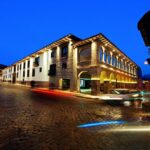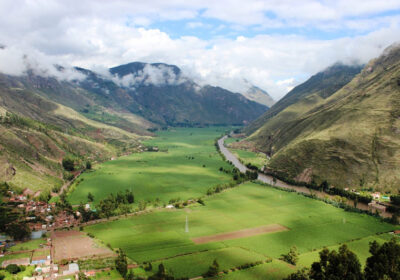
The Inca Empire’s great celebration: Inti Raymi.
The Inca ceremony known as Inti Raymi, or the Festival of the Sun, celebrates the sun god Inti every June 24 in Cusco, coinciding with the winter solstice. The festival provides an opportunity for the Inca and priests to give thanks for the harvest and ask for prosperity in the new agricultural cycle. During the ritual, they dance and sing while making offerings of chicha, coca leaves, and llamas. They also light the new fire with the sun’s rays. Although colonial authorities banned the festival, it has taken place annually since 1944 and now plays an important role in Andean cultural heritage, attracting thousands of visitors.
Table Of Content
What is the Inti Raymi?
Also known as the Festival of the Sun, it served as the most important festival of the Inca Empire. People dedicated this religious celebration to Inti, the Sun God, who was the most venerated deity in Inca religion. They held the main ceremony during the winter solstice to mark the start of the Andean new year.
According to Inca tradition, Inca Pachacutec established the festival in 1430 BC to signify the beginning of the new year in the Inca calendar. Today, locals celebrate this festival on 24 June every year in Cusco, the ancient capital of the Inca Empire. Hundreds of artists dressed in colorful costumes participate in the ceremony to emulate the Inca era.
But why 24 June? This date marks the shortest day of the year and the start of the winter solstice in the southern hemisphere. Theories suggest that the Incas chose this day to implore the return of the sun and longer days.
Approximately 25,000 well-dressed actors, dancers, and musicians perform various activities outside the Coricancha complex, Sacsayhuaman, and the Plaza de Armas in Cusco.
During the festival, speakers give many speeches in Quechua, also known as Runa Simi, the language of the Incas. Quechua was the most widely spoken language in the Inca Empire, and today, it stands as one of Peru’s three official languages.
Inti Raymi in Inca Times
According to chroniclers, thousands of people gathered in Haukaypata (today’s Plaza de Armas) the night before the celebration to await the appearance of the sun god, Inti. When Inti ascended between the mountains, the inhabitants expressed their gratitude for a prosperous new year of harvests. The Sapa Inca, nobles, and priests gathered to witness a parade, bringing ancestral mummies wrapped in cloth from temples and shrines.
Inca Pachacuti established the festival, which lasted 15 days and took place from dawn to dusk. Ceremonial knives called Tumis were used to sacrifice many black llamas. Priests examined the llamas’ organs to predict the future before they incinerated the animals. Women represented by the Coya and the chosen women, or “Acllas,” performed rituals to accompany the ceremony.
After the Spanish conquest, Viceroy Francisco de Toledo prohibited the Inti Raymi, viewing it as a pagan ceremony contrary to the Catholic faith. However, the festival continued in secret until the writer Garcilaso de la Vega discovered it. In 1944, Faustino Espinoza Navarro revived the traditional event and staged a historical reconstruction. Since then, people have celebrated the festival publicly again, attracting thousands of tourists every year.

Today’s Inti Raymi
Today, people celebrate the Inti Raymi in all its splendor, although Cusco no longer hosts a procession of mummies. The festivities begin in the morning on the esplanade of the Temple of the Sun. Representatives of the four suyos of the Inca Empire (Qollasuyu, Kuntisuyu, Antisuyu, and Chinchaysuyu) arrive, and the Sapa Inca inaugurates the festivities. Attendees then walk a short distance to the Plaza de Armas to witness the Inti Raymi celebration.
On June 24, the main day of the festival, the Sapa Inca takes the stage in front of the pilgrims and drinks chicha de jora, a corn-based beverage, in honor of Inti. Next, a priest enters the temple and lights a flame. Dancers perform, and the sounds of conch shells and musical instruments fill the air.
Afterward, everyone gathers at the Santo Domingo Church in the Coricancha complex to begin the nine-day ceremony. Actors portray the Sun King and his wife, Mama Ocllo.
The final part of the story unfolds at the archaeological site of Sacsayhuaman. The Inca king delivers a speech praising the sun. Then, his retinue carries him in a golden chariot to the ruined temple of Sacsayhuaman. There, the Sapa Inca addresses the pallbearers, who wear attire representing different elements: one dresses as a snake to symbolize the underworld, another as a puma to represent earthly life, and a third as a condor to embody the heavens.
Surrounded by thousands of locals and tourists, the Inca delivers his speech in Quechua. Next, performers simulate a llama sacrifice, allowing the Inca’s heart to rise to Pachamama to ensure the next harvest. The audience follows the chariot carrying actors portraying Inca nobles and priests. Women throw exotic flowers along the festival path and sweep it to keep evil spirits away.
Special dances unfold along the way, and participants read and then burn coca leaves in abundance.
The festival culminates when the sound of trumpets, drums, and other instruments fills the air. At sunset, someone lights a bonfire, and the procession returns to Cusco with the Inca king and his wife in their chariot, concluding the ceremony.
The Inti Raymi is a cultural heritage.
Despite globalization, the descendants of the Incas have preserved and proudly expressed their culture. On March 2, 2001, the government declared the Inca New Year festival, also known as the Inti Raymi, a Cultural Heritage of the Nation. Currently, the Provincial Municipality of Cusco manages and organizes the festival.
The festival has also become an important tourist attraction in Peru, drawing visitors from all over the world. This supports the local economy and increases international awareness of and appreciation for the rich cultural heritage of the Andean peoples.
Why should you attend the Festival of the Sun?
Inti Raymi is celebrated in Cusco, a popular destination for history lovers due to its culture, museums, archaeological sites, natural diversity, and friendly locals. The festival attracts national and local tourists, as well as visitors from around the globe, who walk through Cusco’s fascinating, historic streets to witness the magnificent staging of Inti Raymi.
The festival is a great opportunity to enjoy the city’s authentic artistic and folkloric performances. Here are some other reasons why you shouldn’t miss the Festival of the Sun:
1. Cultural Experience: Attending the Inti Raymi festival allows you to immerse yourself in a deeply enriching cultural experience. As one of Peru’s most significant traditional celebrations, the festival provides an opportunity to delve into the rich heritage of the Andean people and their Inca ancestors.
2. Spectacular Performances: The festival features vibrant, colorful performances with hundreds of artists wearing traditional Inca jewelry and costumes. The theatrical reenactment of ancient rituals is a grand spectacle that includes music, dance, processions, and a simulated llama sacrifice. Rest assured, real sacrifices are no longer performed at this festival.
3. Historical Significance: The festival takes place at historical sites in Cusco, including the ancient Inca Temple of the Sun (Qoricancha), the Plaza de Armas, and the Sacsayhuaman archaeological site. You can explore these sites while enjoying the festival.
4. Beautiful scenery: The event takes place in and around Cusco, a city nestled high in the Andes Mountains. The city and its surroundings offer breathtaking scenery, making it an excellent place to visit.
5. Meet new people!
The festival attracts visitors from all over the world, making it an ideal place to interact with people from different cultures and backgrounds. It also provides an opportunity to interact with locals and learn about their customs and way of life.
6. Photographic Opportunities: The colorful costumes, dramatic reenactments, and historical settings provide fantastic photo opportunities.
The festival’s colorful costumes, dramatic performances, and historical settings offer fantastic opportunities for photography enthusiasts.
How can you enjoy this festival?
There are two ways to experience the Inti Raymi festival in Cusco.
1. You can reserve seats in advance, which will give you uninterrupted access to the event sites. 2. You can watch the event standing among the locals, which will give you a better understanding of the event’s importance.
Places you will see during the event:
Qoricancha:
Although there is no official seating to watch the festival here, there is plenty of open space where you can stand and watch the start of the event. The festival takes place in the gardens outside the temple, where you can enjoy fascinating views. It is best to arrive early to get a good spot and enjoy the best views.
Plaza de Armas:
Although the festivities are not cordoned off, there is still space around the colonial arcades. Due to the limited space, be prepared to be in the crowd.
If you plan to see the Inti Raymi, we recommend reserving a table at a café or restaurant with a balcony overlooking the main square. From there, you will have a great view of the event.
Sacsayhuaman:
Locals who cannot afford the entrance fee watch the Inti Raymi from two hills in front of the stage. The best way to enjoy the ceremony is to reserve a seat through a guide or travel agency and watch the spectacle from the grandstands. Seats are sold in order of priority.
What is the program for Inti Raymi?
9:00 a.m.: The festivities begin at the Temple of the Sun, Qoricancha.
The Inca, along with La Qoya and the royalty, will greet the god Inti to invoke the success of the ceremony. “O Sun God, our father, mighty Sun of eternal happiness, warm source and principle of life! From your sacred mansion in Cusco, where you reside with the Moon, Lightning, and Thunder, your children of the Empire of the Four Regions greet you with reverence on your jubilee day.”
10:30 a.m. – Plaza de Armas
After the first part of the Inca Sun Festival concludes at the Qoricancha, the Inca, his royal entourage, and the imperial army proceed through ancient Inca streets, such as Loreto Street, to the Plaza de Armas and arrive at Aucaypata. There, the ñustas and aqllas (chosen women), as well as the entire imperial army, are already in position waiting for the Inca. As the highest ruler of the empire, the Inca performs the coca ceremony and makes an invocation to the apus.
1:45 p.m. — Esplanade of Chuquipampa or Sacsayhuaman.
After the coca ceremony in Aucaypata Square, the cast heads to the Sacsayhuaman archaeological park esplanade. Approximately 80,000 people and 3,500 tourists who purchased seats in the stands on the esplanade are waiting for the main ceremony.
Be prepared for the crowds and bring everything you need for the day, including plenty of food, water, and sun protection. First come, first served!













